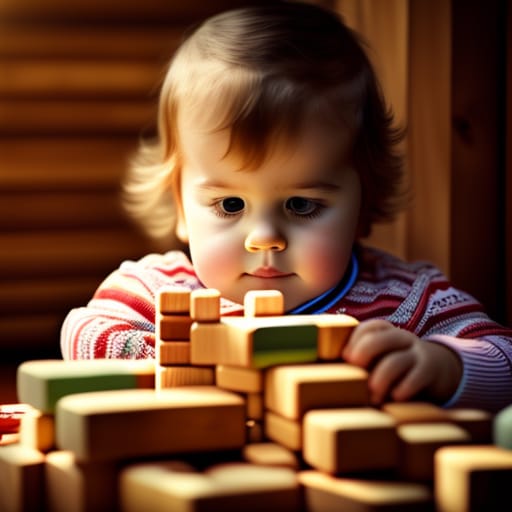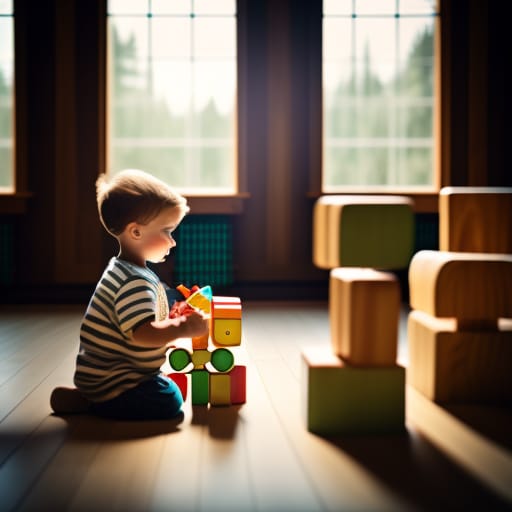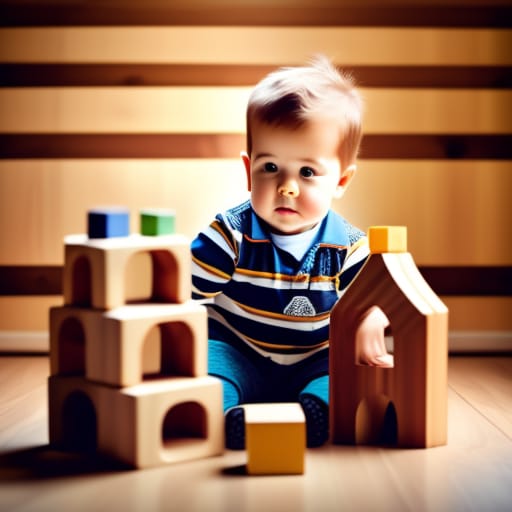Giant building blocks are oversized, modular blocks that allow children and adults to build massive structures together. These blocks open up immense possibilities for education, motor skills development, and just plain fun. This beginner’s guide will explore the world of giant building blocks – their benefits, popular types, how to use them, and top recommendations to ignite your imagination.

An Introduction to Building Big
Giant building blocks, also known as oversized blocks or large hollow blocks, are much larger versions of traditional wooden unit blocks. They are designed to enable children and families to build large-scale structures together that would not be possible with smaller blocks.
Some key features of giant building blocks:
- Oversized – Dimensions ranging from 4 to 6 inches
- Lightweight – Made from durable foam or plastic
- Modular – Interlock together in different configurations
- Portable – Easy to assemble, disassemble and store away
- Safe – Rounded edges and lightweight material
Building with giant blocks fosters key developmental skills in children including:
- Creativity and Imagination – Building unique structures
- Collaborative Play – Working together to build
- Spatial Reasoning – Figuring out how blocks fit together
- Motor Skills – Lifting and connecting blocks develops muscles
- Structural Engineering – Understanding stability and balance
For parents and children alike, the larger scale brings out the kid in all of us. Let’s explore why giant blocks are the perfect tool for learning through play.
Benefits of Giant Building Blocks
There are many developmental benefits to building with oversized blocks:
Promote Creativity and Imagination
- The larger scale enables kids to build bigger structures than possible with small blocks. This allows their imagination to run free.
- Open-ended play encourages creativity as kids can build almost anything they can think of.
Develop Motor Skills
- Lifting and connecting the larger blocks builds muscular strength and coordination.
- Kids engage their core and limbs to lift, rotate, and place blocks.
- Develops gross motor skills as kids move around structures.
Encourage Collaborative Play
- Family members can work together to build, promoting bonding.
- Teamwork helps kids practice communication and sharing.
- Collaborative skills like planning, dividing tasks, and compromising are utilized.
Enhance Spatial Reasoning
- Figuring out how the 3D blocks fit together boosts spatial intelligence.
- We are learning about stability, balance, and geometry through hands-on play.
- Visualizing and rotating shapes in the mind improves spatial cognition.
Inspire STEM Learning
- Discovering concepts like gravity, friction, and momentum hands-on.
- An engineering mindset is built by creating strong structures.
- Real-world application of math, science, and physics principles.
-Problem-solving skills developed when structures topple.
Giant building blocks are an engaging way to nurture creativity, imagination, cooperation, and STEM skills!
Types of Giant Building Blocks
There are a few common types of oversized building blocks:
Foam Blocks
- Made of light, durable foam (usually EVA)
- Softer with rounded corners for safety
- Vibrant colors like red, green, and blue for engaging play
- Budget-friendly option
Plastic Blocks
- Made of durable, BPA-free plastic
- Textured for grip, sometimes with rubber edges
- Brighter colors than wood blocks
- Lightweight but sturdy
Wooden Blocks
- Traditional wooden unit blocks scaled up in size
- Natural maple wood grain finish
- Stained in colors or painted as desired
- Naturally smooth, lightweight
Specialty Blocks
- Rock wall blocks for climbing
- Extra large oversized blocks
- Building planks and boards
- Wheels, doors, windows, arches
Choose blocks that are large enough for easy gripping and structural stability. High-quality blocks will last through rough play and frequent use.
| Type | Materials | Texture | Weight | Price |
|---|---|---|---|---|
| Foam Blocks | EVA foam | Smooth | Light | $ |
| Plastic Blocks | HDPE plastic | Textured | Medium | $$ |
| Wooden Blocks | Maple wood | Smooth | Medium | $$$ |
Getting Started with Giant Building Blocks
Ready to introduce some jumbo building blocks for your kids? Here are some tips:
- Start small – Just a few blocks is all you need to get engaging structures going
- Organize pieces – Sort blocks by shape, and color for easy building
- Build on a flat surface – A level play area prevents tipping accidents
- Supervise play – Ensure safe, collaborative building
- Encourage imagination – Let kids build whatever they dream up
- Snap photos – Capture the progress and finished structures
- Display creations – Show off constructions before disassembling
- Store neatly – Use bins, and bags to organize and contain pieces
Giant building blocks are easy to use. Simply let your child’s creativity guide the building process. Lend a hand for stability with taller structures. Then watch imaginations soar!<div class=”infographic”>

Top Giant Building Block Sets
Here are our top picks for starter sets of oversized building blocks:
1. Kido Giant Foam Blocks – 96 Pieces
- Durable, lightweight EVA foam blocks in 8 shapes and colors
- 96 pieces with a storage bag
- Best for ages 1-5 years
- Budget-friendly price under $40
Pros
- Lightweight for small hands
- Rounded edges for safety
- Bright colors for visual stimulation
Cons
- Not as sturdy as plastic or wood
- Foam absorbs teething marks over time
2. PLAYTIV Premium Jumbo Blocks – 80 Pieces
- BPA-free plastic blocks in colorful shapes
- Textured for easy gripping
- Compatible with leading brands
- Ideal for ages 1-6 years
- Under $50 for 80 piece set
Pros
- BPA-free, child-safe plastic
- Rubber edges prevent slipping
- Vibrant colors and a variety of shapes
Cons
- Not as lightweight as foam or wood
- Makes more noise when connecting
3. Maple Landmark Jumbo Set – 46 Pieces
- Heirloom quality solid maple wood blocks
- The smooth, natural finish shows the wood grain
- Contains shapes like arches, ramps, cylinders
- Ages 3+ years
- USA made, under $120
Pros
- Real wood with beautiful grain
- Naturally smooth, lightweight
- Made in America quality
Cons
- No color or painted options
- Pricey for a starter set
Creative Ideas for Building
The possibilities are endless when building with giant blocks! Here are some fun structure ideas:
- Castles and forts
- Towers and skyscrapers
- Bridges and tunnels
- Enclosure and maze
- Space station
- Garage and cityscape
- Farm and animal pens
- Rocket ships
- Robot
Let kids take the lead dreaming up what to construct. Offer help engineering tricky connections. Embrace failures as learning opportunities while keeping them lighthearted.
Developing Skills Through Block Play
Beyond fostering creativity, here are key skills giant building blocks can help develop
- Problem-solving – Finding solutions when structures topple
- Spatial reasoning – Envisioning 3D shapes and rotations
- Motor skills – Lifting, gripping, carrying blocks
- Cooperation – Collaborating to build together
- Communication – Explaining ideas and plans
- Math concepts – Counting, shapes, measuring, balance
- Science concepts – gravity, friction, motion physics
Reinforce the learning by asking questions and having kids explain their thinking. Make connections to real-world examples like architecture and engineering.
Safety First with Giant Blocks
While giant blocks provide safe, educational fun, always supervise children during use. Follow these tips:
- Set up blocks on flat, sturdy surfaces away from stairs
- Watch for toppling structures to avoid accidents
- No piling blocks above shoulder height
- Ensure blocks are appropriate size and weight for the child’s abilities
- Monitor use around younger siblings and pets
- Teach children to carry one block at a time with both hands
With proper adult supervision, giant blocks offer a world of learning and imagination in a safe setting.
Make Learning Fun for All Ages
Giant building blocks are not just for kids – they bring out the inner child in everyone. Here are some ideas:
- Family build-offs to see who can construct the tallest tower
- Adult social nights with giant blocks as interactive entertainment
- Teambuilding exercises at schools and summer camps
- STEM education uses blocks to teach concepts
- Senior community center building projects to stay sharp
No matter your age, giant blocks provide fun interactive learning!

Ignite Endless Possibilities
At a time when kids are spending more time on screens, giant building blocks encourage hands-on learning through play. The larger scale enables young minds to build bigger structures and gain mastery over their environment. Develop fine and gross motor skills, imagination, cooperation, and problem-solving with simple structured play.
Giant blocks open up a world of possibilities. The open-ended creativity, STEM learning, and bonding opportunities are virtually endless. Scale up your building fun and unlock learning with giant blocks today!
More Resources:
How Block Play Supports Early Learning
Importance of Block Play in Child Development
Benefits of Playing with Blocks
Frequently Asked Questions
What are the best giant building blocks for toddlers?
The best giant blocks for toddlers are lightweight foam or plastic blocks with rounded corners for safety. Prioritize large sizes like 4-6 inches for easier gripping. Bright colors are ideal for visual stimulation. Sets under 50 pieces help avoid overstimulation.
How do giant blocks support STEM learning?
Giant blocks provide hands-on learning about concepts like gravity, friction, balance, and geometry. Kids utilize engineering and spatial reasoning skills to create strong structures. Experimenting with physics in an engaging way supports early science, technology, engineering, and math comprehension.
What skills do giant blocks develop?
Building with oversized blocks develops fine and gross motor skills, hand-eye coordination, creativity, imagination, problem-solving, cooperation, communication, and spatial intelligence. Structured block play lays the foundation for early math and science skills too.
What are giant building blocks made of?
Giant blocks are typically made from durable EVA foam, BPA-free plastic, or wood like maple. Foam is lightweight but less sturdy. Plastic withstands frequent use but is heavier. Maple wood offers beautiful smooth grain but no color options.
Are giant blocks safe for toddlers?
Giant blocks are safe for supervised play. Ensure blocks have rounded edges and are lightweight enough for toddler abilities. Only build on flat surfaces and limit stack height. Monitor use around younger kids and pets. Teach safe carrying and sharing of blocks.